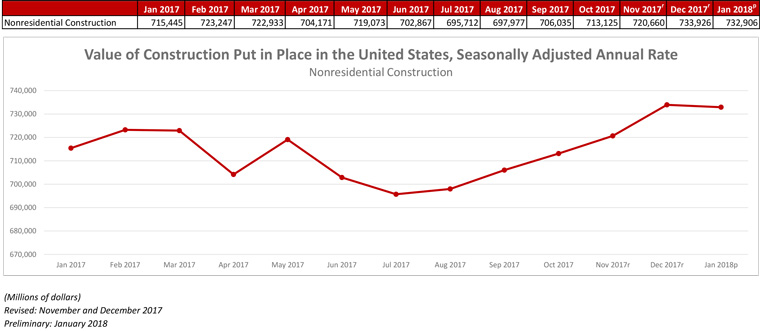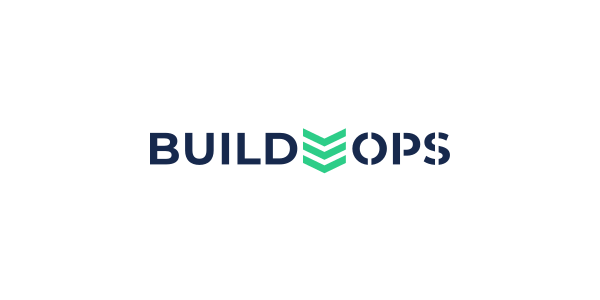
Key Takeaways
- Nonresidential construction spending decreased 0.1 percent in January, totaling $732.9 billion on a seasonally adjusted basis, marking a decline from the previous 5 months of increases.
- Economists polled by Reuters had forecast construction spending increasing 0.3 percent in January after a previously reported 0.7 percent advance in December. Construction spending increased 3.2 percent on a year-on-year basis.
- “Potential double-digit tariffs or import restrictions on steel and aluminum could wreck the budgets for numerous infrastructure projects and private nonresidential investments."
Press Release from Associated Builders and Contractors, Inc.
WASHINGTON, March 1—Nonresidential construction spending fell 0.1 percent on a monthly basis in January 2018, while year-over-year spending increased, according to an Associated Builders and Contractors (ABC) analysis of U.S. Census Bureau data released today. Nonresidential January spending totaled $732.9 billion on a seasonally adjusted annual rate, adding up to a 2.4 percent increase year over year.
Private nonresidential construction fell 1.5 percent for the month, while public sector nonresidential spending increased 1.9 percent. The largest year-over-year increases occurred in public safety (33.5 percent) and transportation (20.2 percent).
“Today’s data indicates that nonresidential spending continues to expand erratically and unevenly,” said ABC’s Chief Economist Anirban Basu. “On a monthly basis, nonresidential construction spending declined in January. While the decline was minimal, and may have been primarily attributable to freezing temperatures in much of the country, there has been a long-lived pattern of occasional spending setbacks in the context of broader expansion cycles. The result of the most recent spending setback is that nonresidential construction outlays are only 2.4 percent above year-ago levels.
“Interestingly, there is evidence of a reversal of fortune as spending picks up in certain public segments while flattening out in certain private ones,” said Basu. “With the housing market recovering, property tax and other forms of real estate tax collections have increased. This has positioned a growing number of public agencies to step up construction spending in education, public safety and other publicly financed categories.
“Meanwhile, there are growing concerns regarding excess inventory of commercial and office space in certain metropolitan areas,” said Basu. “This may help explain recent construction spending setbacks in a variety of privately financed construction segments. That said, there is little reason to believe that private construction will falter in 2018. Economic growth, including job growth, remains robust. Confidence is surging among many economic actors, including bankers and developers. The combination of capital and confidence should be enough to drive spending growth in most private segments as 2018 progresses.”
Press Release from Associated General Contractors of America
March 1, 2018
Construction Spending in January Matches December, Rises from a Year Ago; Harmful Actions on International Trade Put Further Increases at Risk
Association Officials Warn Policy Makers That Additional Steel and Aluminum Tariffs or Import Restrictions Would Jeopardize Much-Needed Infrastructure Investments and Private Construction Projects
Construction spending in January was unchanged from December and was moderately higher than in January 2017, according to an analysis of new government data by the Associated General Contractors of America. However, association officials said further gains, especially in desperately needed infrastructure investment, would be in jeopardy if the administration adopts tariffs on key construction materials.
“Construction spending in January showed a mixed pattern, with noteworthy increases in public outlays and single-family homebuilding balancing out declines in private nonresidential and multifamily investments,” said Ken Simonson, the association's chief economist. “Unfortunately, all categories are threatened by the harmful actions under consideration regarding steel and aluminum.”
Construction spending in January essentially matched the upwardly revised December record level of $1.263 trillion at a seasonally adjusted annual rate. The January total exceeded the year-earlier level by 3.2 percent. For the month, private nonresidential construction spending rose 0.3 percent, private residential spending declined 1.5 percent, and public construction spending gained 1.8 percent. On a year-over-year basis, private residential construction spending increased 4.2 percent, private nonresidential spending slipped 1.1 percent, and public construction spending jumped 8.2 percent.
“Results for January are not necessarily indicative of how the year will play out, as abnormal weather patterns in either the latest month, preceding month or year-ago month can distort comparisons,” Simonson cautioned. “The underlying trends appear to point to a recovery in manufacturing, pipeline and power construction among private nonresidential categories; strong private and public investment in airports and schools; and a flattening or weakening of office and multifamily spending.
“However, many projects are vulnerable to steep increases in materials costs,” the economist said. “Already, prices have jumped for lumber, steel and aluminum. Potential double-digit tariffs or import restrictions on steel and aluminum could wreck the budgets for numerous infrastructure projects and private nonresidential investments. In addition, any countermeasures taken by U.S. trading partners that are affected by these measures would harm U.S. exporters, transportation and logistics businesses, and ports, which would reduce demand for a variety of construction categories.”
Association officials called on the White House and federal agencies to avoid triggering a “trade war.” The officials said tariffs on steel and aluminum would undermine the administration’s goals of dramatically boosting infrastructure investment and achieving sustained higher economic growth.
“Making construction, infrastructure and development projects more expensive by imposing new trade barriers will do far more damage to the economy than any limited benefits new tariffs or quotas might provide,” said Stephen E. Sandherr, the association’s chief executive officer. “Worse, increasing the cost of construction will only undermine the President’s ambitions to rebuild the nation’s aging and over-burdened infrastructure.”
Reporting from CNBC:
ISM manufacturing index hits 60.8 in February; construction spending unchanged in January
U.S. Construction spending growth was flat in January, underwhelming economists' expectations.
U.S. construction spending was unexpectedly flat in January as a surge in investment in public construction projects was offset by a decline in private outlays.
The Commerce Department said on Thursday the virtually unchanged reading in construction spending followed an upwardly revised 0.8 percent jump in December.
Economists polled by Reuters had forecast construction spending increasing 0.3 percent in January after a previously reported 0.7 percent advance in December. Construction spending increased 3.2 percent on a year-on-year basis.
In January, spending on private construction projects fell 0.5 percent after increasing 0.6 percent in December. Outlays on private residential projects rose 0.3 percent after dropping 0.5 percent in December.
Spending on nonresidential structures tumbled 1.5 percent in January, almost reversing December's 1.8 percent jump.
Outlays on public construction projects increased 1.8 percent in January to the highest level since August 2015, after rising by the same margin in December.
Spending on federal government construction projects vaulted 14.9 percent to the highest level since September 2011. State and local government construction outlays rose 0.5 percent to levels last seen in March 2016.
Reporting from Fox News:
US construction spending flat as commercial building falls
WASHINGTON – Spending on U.S. construction projects was unchanged in January, held back by a sharp fall in commercial real estate building.
The Commerce Department said Thursday that spending on the construction of single-family homes rose 0.6 percent, while apartment building fell. Construction of commercial projects, such as office towers and malls, fell 2.7 percent. Construction spending on new power plants plunged 6.2 percent.
Construction spending rose in 2017 at the slowest pace in six years, as homebuilders have struggled to find enough workers and enough cheap land to build on. Total private construction fell 0.5 percent in January.
States and the federal government have made up for some of the decline, increasing their construction spending 1.8 percent in January. Federal spending soared 14.9 percent to the highest level in more than seven years.
Spending on highway and road building rose 4.4 percent and construction of schools increased 2.1 percent.













